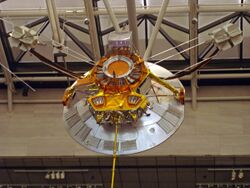Space probe
Topic: Engineering
 From HandWiki - Reading time: 5 min
From HandWiki - Reading time: 5 min

Template:Needs more references
A space probe is an artificial satellite that travels through space to collect scientific data.[1] A space probe may orbit Earth; approach the Moon; travel through interplanetary space; flyby, orbit, or land or fly on other planetary bodies; or enter interstellar space.
Many countries and private companies have launched probes to planets, asteroids, moons around the Solar System, including the Soviet Union, the United States , India , and many more.
History
On 4 October 1957, the first artificial satelite to orbit Earth was Sputnik 1, launched by the USSR. One year later, on 1 February 1958, Explorer 1 was launched by the United States, being the first space probe. Explorer 1, collecting data on temperature, cosmic rays, and micrometeorite impacts.[2] The first attempted lunar probe was the Luna E-1 No.1, launched on 23 September 1958. The goal of a lunar probe repeatedly failed until 4 January 1959 when Luna 1 orbited around the moon and then the sun.
The success of these early missions began a race between the US and the USSR to outdo each other with increasingly ambitious probes. Each new satellite cast a shadow on the one that came before. Mariner 2 was the first probe to study another planet, revealing Venus' extremely hot temperature to scientists in 1962, while the Soviet Venera 4 was the first atmospheric probe to study Venus. Mariner 4 's 1965 Mars flyby snapped the first images of its cratered surface, which the Soviets responded to a few months later with images from on its surface from Luna 9. In 1967, America's Surveyor 3 gathered information about the Moon's surface that would prove crucial to the Apollo 11 mission that landed humans on the moon two years later.[3]
The first interstellar probe was Voyager 1, launched 5 September 1977. It entered interstellar space on 25 August 2012,[4] followed by its twin Voyager 2 on 5 November 2018. [5] Both have collected science outside the heliosphere.
Characteristics
A space probe generally need an antenna to communicate back with Earth.
Trajectories
Once a probe has left the vicinity of Earth, its trajectory will likely take it along an orbit around the Sun similar to the Earth's orbit. To reach another planet, the simplest practical method is a Hohmann transfer orbit. More complex techniques, such as gravitational slingshots, can be more fuel-efficient, though they may require the probe to spend more time in transit. Some high Delta-V missions (such as those with high inclination changes) can only be performed, within the limits of modern propulsion, using gravitational slingshots. A technique using very little propulsion, but requiring a considerable amount of time, is to follow a trajectory on the Interplanetary Transport Network.[6]
See also
Note: This topic belongs to "Spaceflight" portal
References
- ↑ "NASA – What Is a Space Probe?" (in en). 25 February 2010. https://www.nasa.gov/centers/jpl/education/spaceprobe-20100225.html.
- ↑ "NASA Jet Propulsion Laboratory – Explorer 1". https://explorer1.jpl.nasa.gov/about/#the_success.
- ↑ "NASA Jet Propulsion Laboratory". https://www.nasa.gov/centers/jpl/education/spaceprobe-20100225.html.
- ↑ Barnes, Brooks (12 September 2013). "In a Breathtaking First, NASA's Voyager 1 Exits the Solar System" (in en-US). The New York Times. ISSN 0362-4331. https://www.nytimes.com/2013/09/13/science/in-a-breathtaking-first-nasa-craft-exits-the-solar-system.html.
- ↑ Potter, Sean (9 December 2018). "NASA's Voyager 2 Probe Enters Interstellar Space". http://www.nasa.gov/press-release/nasa-s-voyager-2-probe-enters-interstellar-space.
- ↑ "E&S+". http://pr.caltech.edu/periodicals/EandS/articles/LXV4/exit.html.
40 views | Status: cached on July 22 2024 18:19:57
↧ Download this article as ZWI file
 KSF
KSF

